
QUBIT AI: Hassan Ragab
Audio Responsive Treehouse
FILE 2024 | Architectural Synthetics
International Electronic Language Festival
Hassan Ragab – Audio Responsive Treehouse – United States
This work, created using generative artificial intelligence tools, is part of a broader exploration into discovering architectural forms through the intersection of different media. Potential shapes are generated based on the rhythms and timbres of the Shockone vs. Shockone song Run. The Bloody Beetroots. Factors such as camera movement and dynamics between the interior and exterior of the treehouse contribute to the creative process.
Bio
Hassan Ragab is an interdisciplinary media artist, architect and designer whose work focuses on the synergy between art, architecture, technology and humanity. He uses generative artificial intelligence to create a new visual language, and his work is exhibited globally. Additionally, Hassan writes about the integration of new media into art and design and has been recognized in numerous publications and news outlets.

QUBIT AI: Michael Sadowski (aka derealizer)
In Love
FILE 2024 | Interator – Sound Synthetics
International Electronic Language Festival
Michael Sadowski (aka derealizer) – In Love – Austria
Fractal structures move to the sound of progressive house as the virtual camera navigates through this fractal world. To intensify the psychedelic quality, a second layer contrasts with the movement, resulting in a joyful madness of colors.
Bio
Using Stable Diffusion, a visual synthesizer, the artist turns fantasies into videos using just a PC, similar to the invention of printing 600 years ago. Exploring the interplay between software algorithms that create visual worlds and the artist’s mind guiding this process is incredibly exciting. Unlike traditional cinema, there is no ‘reality’ or humans involved, making it a satisfying medium for creating visual art.
Credits
Music: Y do I
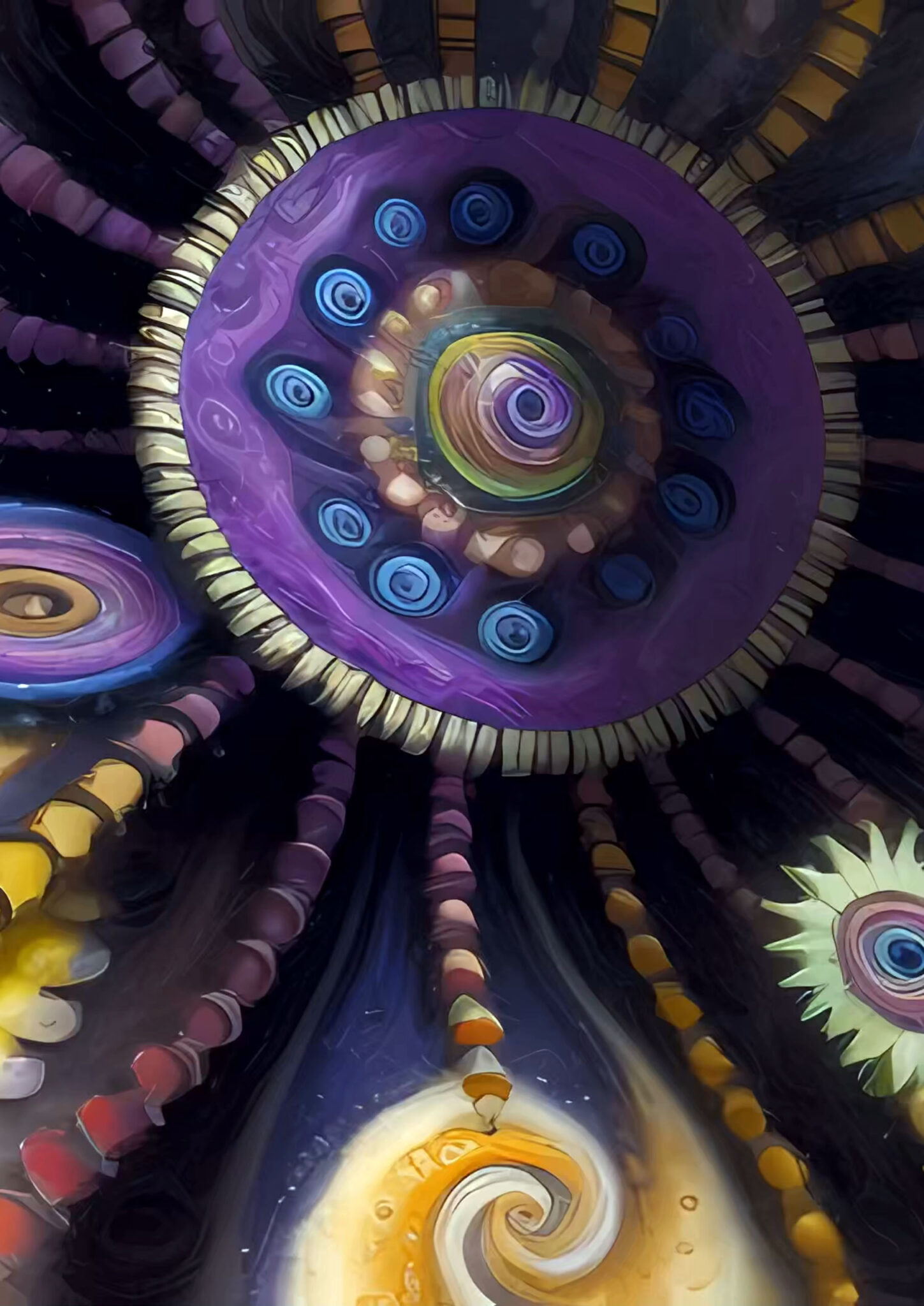
QUBIT AI: Dennis Schöneberg
Transparency
FILE 2024 | Interator – Sound Synthetics
International Electronic Language Festival
Dennis Schöneberg – Transparenza – Germany
Music controls camera settings, the weight of prompts, and the creativity of the AI. The objective of the project is to create a symbiosis between music and images, in which both elements complement and enhance each other. By directly linking musical parameters to AI creative processes, a unique audiovisual experience is created.
Bio
Dennis Schöneberg, German AI artist, data science student and developer of open source AI models, integrates his passion for electronic music into his creative endeavors. Merging art with technology, he explores the synergy between creativity and artificial intelligence.
Credits
Music: Transparenza by Michael Mayer & Reinhard Voigt

QUBIT AI: Gabriela Barreto Lemos
Quantum Photography
FILE 2024 | Quantico
International Electronic Language Festival
Gabriela Barreto Lemos – Quantum Photography – Brazil
Quantum photography technique that allows you to record images without light passing through the object.
Typically, a beam of light interacts with an object; In this same beam, the image of that object is formed, which is recorded on a camera, on paper or directly into the eye. This research used two quantumly entangled photon beams. An infrared photon was directed at a silicon wafer engraved with the image of a cat. The other photon, red, was sent on a different trajectory, did not pass through the silicon plate and was detected by an EMCCD (electron-multiplying charge-coupled device – a photographic camera with sensitivity to very low intensity light). The image of the cat engraving was recorded by the camera, which only detected the red light, which did not touch the engraving. It is the first time that an image has been captured in a beam of light that has not interacted with the object that produced the image.
The experiment, led by researcher Gabriela Barreto Lemos, was carried out at the Institut für Quantenoptik und Quanteninformation in Vienna, 2014.
The technique has potential for applications in indirect image capture, from medicine to quantum computing.
Bio
Professor at the Federal University of Rio de Janeiro, in Brazil, whose research focus is on quantum optics, with an emphasis on quantum foundations, quantum images and quantum information. Additionally, she is involved in interdisciplinary creative projects and promoting inclusion and diversity in science.
Credits
Gabriela Barreto Lemos
Vienna Center for Quantum Science and Technology
Institut für Quantenoptik und Quanteninformation
Group of Anton Zeilinger

ERIC SIU
萧子文
エリック·シウ
Touchy
file festival
Touchy is a human camera – a wearable device that literally transforms a human being into a functioning camera. The individual who is wearing the device is constantly “blinded” unless someone touches his/her skin. The touch causes the shutters in front of the eyepieces to open and restores the wearer’s vision. When physical contact is maintained for 10 seconds, the camera takes a “Touch-Snap” (i.e., a photo that is taken by Touchy), which is displayed on the device’s LCD.

Frederik Heyman
CEREMONIAL FORMALITY
Frederik Heyman’s work is a balancing act incorporating multiple media – including video, installations and photogaphy – often in a digitally altered environment. In his work, Heyman explores memory and duration, using photogrammetry and 3D scanning to depict and represent the passage of time. The hallmarks of Heyman’s work are mechanical and technological: wires, wheels, scrolling LED marquees, metal frames, clamps, industrial lights, screens and cameras. Bodies–as opposed to humans–are subject to unusual dynamics with these technological trappings. In Ceremonial Formality (2020) a contortionist is encased in a metal cage while a spectator, hooked up to wires, looks on.

Roy Andersson
A Pigeon Sat on a Branch Reflecting on Existence
A sense of depression is reflected in his reluctance to use close-ups or camera movement, yet Andersson has quite an eye for beautiful set-ups even within the restrictions he’s given himself. His sense of humor is deadpan and misanthropic yet humanist. Andersson’s dour wit isn’t far from Louie. A Pigeon Sat On a Branch Reflecting On Existence expects the worst from the human race but holds out a slim hope for the best.
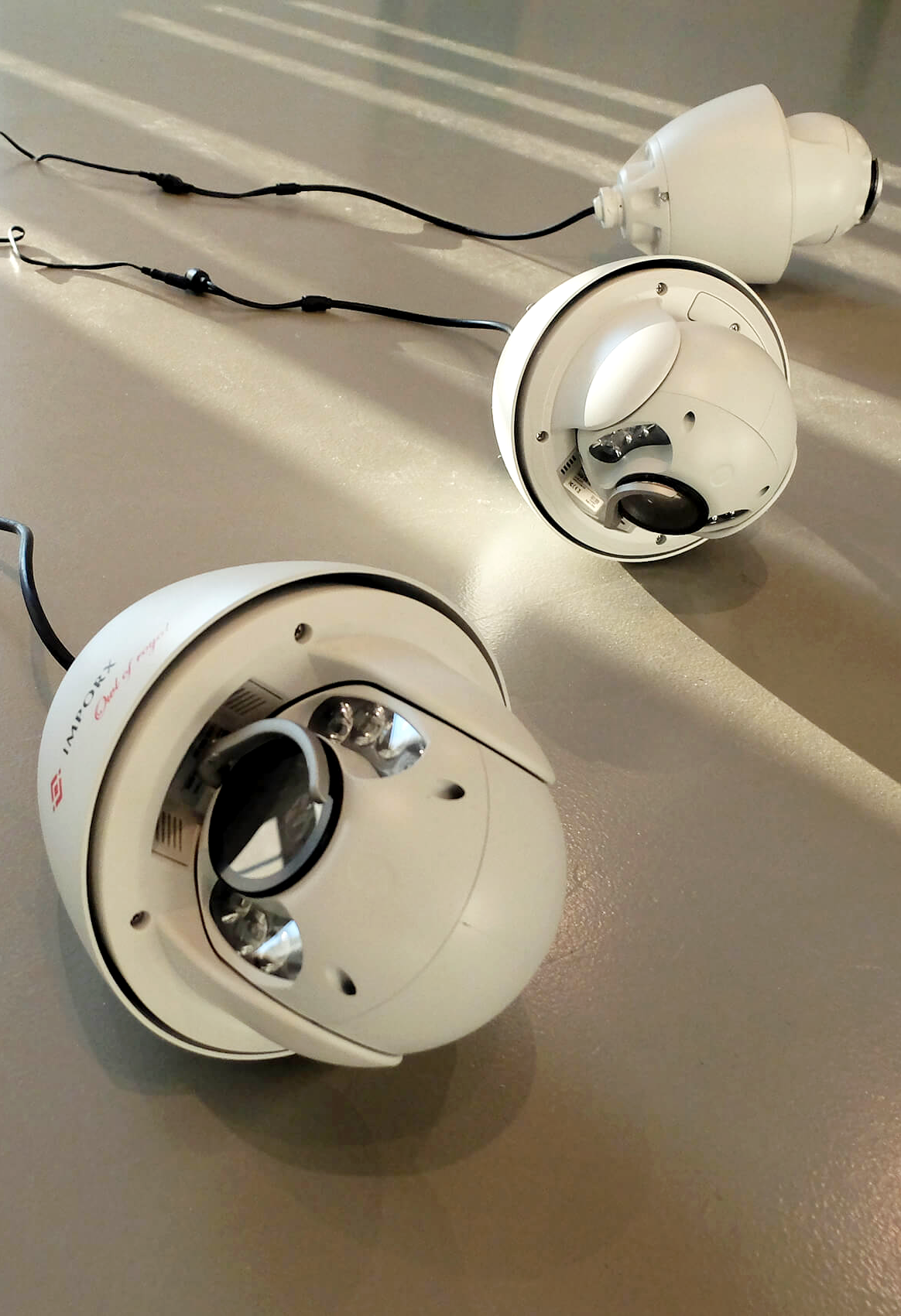
Aram Bartholl
Pan, Tilt and Zoom
Three motorized CCTV dome cameras are installed on the gallery floor. The built-in auto-tracking function makes the cameras follow any motion in the room. While moving its lens the center of the weight of the device shifts and the whole camera starts to roll on the floor. As a result the software is confronted with even more motion which needs to be tracked. From time to time the cameras bump into each other or start to follow and trigger each other movements.

LAUREN LEE MCCARTHY
Lauren
J’essaie de devenir une version humaine d’Amazon Alexa, une intelligence domestique intelligente pour les personnes dans leur propre maison. Le spectacle dure jusqu’à une semaine. Cela commence par l’installation d’une série d’appareils intelligents en réseau conçus sur mesure (y compris des caméras, des microphones, des commutateurs, des serrures de porte, des robinets et d’autres appareils électroniques). Je surveille ensuite la personne à distance 24h/24 et 7j/7 et contrôle tous les aspects de son domicile. Je vise à être meilleur qu’une IA car je peux les comprendre en tant que personne et anticiper leurs besoins. La relation qui s’en dégage s’inscrit dans l’espace ambigu entre homme-machine et homme-humain.
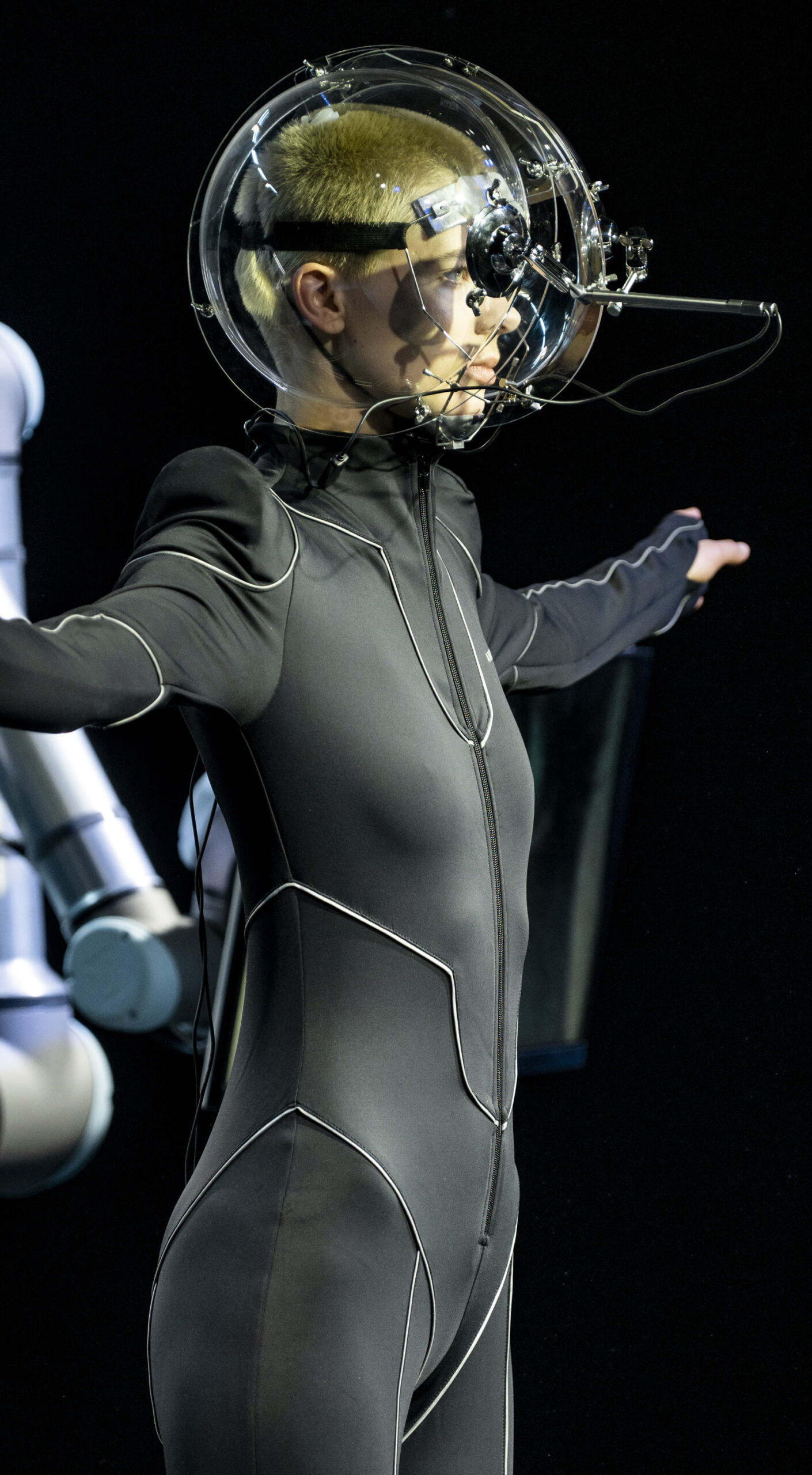
Behnaz Farahi
19Returning the Gaze
‘Returning the Gaze’ is an cyber-physical robotic installation by Behnaz Farahi supported by Universal Robots for ANNAKIKI’s Milan Fashion Week. ‘Returning the Gaze’ is an exploration of this scenario. In the center, a female model wears a spacesuit-like outfit and a headpiece fitted with two tiny cameras. The cameras track and capture the movements of the model’s eyes, and enlarging and displaying them on four monitors mounted moving around on robotic arms glaring back at the observers. The gaze of the model is thereby directed back at the viewer, extended and enhanced through cyborgian technologies.
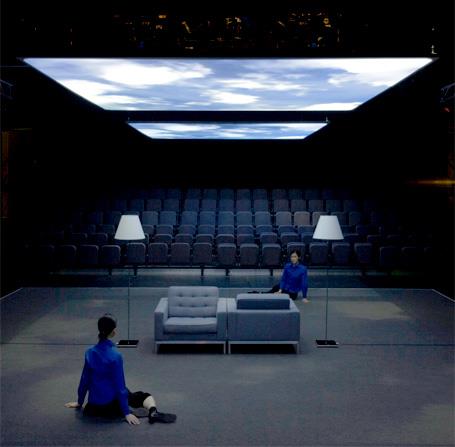
SHIRO TAKATANI
高谷史郎
史郎の高谷
La chambre claire
La Chambre Claire (or Camera Lucida) is a show built up from precise, symmetrical movements, inviting spectators to embark on a thought-provoking journey into their most intimate and personal territory. In this, his first solo work as creative artist and director, Shiro Takatani pays homage to the French writer Roland Barthes and his essay on photography, La chambre claire (1980). The result is a performance that blends theatre, the art of movement and installation to compose a great fresco full of subtle, elegant minimalist images that advance towards an aesthetic climax. Reflecting on photography and memory, the production invites us to embark upon an intimate, solitary journey to look inside ourselves and formulate a personal interpretation of what we see.
.
La Chambre Claire (oder Camera Lucida) ist eine Show, die aus präzisen, symmetrischen Bewegungen aufgebaut ist und die Zuschauer zu einer zum Nachdenken anregenden Reise in ihr intimstes und persönlichstes Gebiet einlädt. In seiner ersten Soloarbeit als kreativer Künstler und Regisseur huldigt Shiro Takatani dem französischen Schriftsteller Roland Barthes und seinem Aufsatz über Fotografie, La chambre claire (1980). Das Ergebnis ist eine Performance, die Theater, Bewegungskunst und Installation miteinander verbindet, um ein großartiges Fresko voller subtiler, eleganter minimalistischer Bilder zu komponieren, die sich einem ästhetischen Höhepunkt nähern. Die Produktion reflektiert Fotografie und Erinnerung und lädt uns ein, eine intime, einsame Reise zu unternehmen, um in uns selbst zu schauen und eine persönliche Interpretation dessen zu formulieren, was wir sehen.
.
La Chambre Claire(またはCamera Lucida)は、正確で対称的な動きから構築されたショーであり、観客を招待して、最も親密で個人的な領域への示唆に富む旅に出ます。この中で、クリエイティブアーティスト兼ディレクターとしての彼の最初のソロ作品である高谷史郎は、フランスの作家ロラン・バルトと彼の写真に関するエッセイ、ラ・シャンブル・クレア(1980)に敬意を表しています。その結果、劇場、動きの芸術、インスタレーションを融合させて、美的クライマックスに向けて前進する繊細でエレガントなミニマリストのイメージに満ちた素晴らしいフレスコ画を構成するパフォーマンスが生まれました。写真と記憶を反映して、この作品は私たちを親密で孤独な旅に乗り出し、自分自身の内部を見て、私たちが見ているものの個人的な解釈を定式化するように誘います。
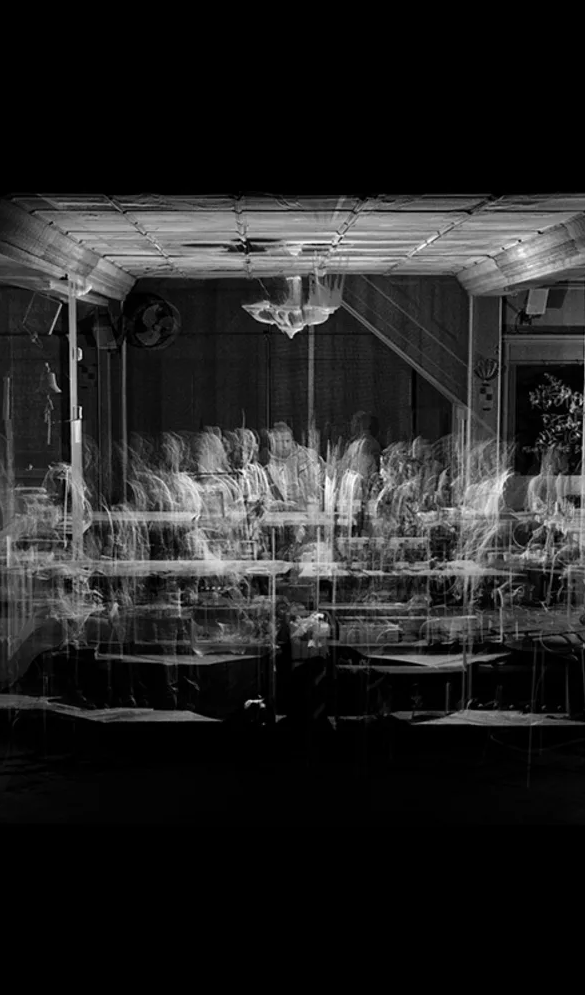
SCANLAB
FRAMERATE
Created from thousands of daily 3D time-lapse scans of British landscapes, the work observes change on a scale impossible to see with the lens of traditional cameras. This is not just an artwork. The data collected and presented by FRAMERATE is ground-breaking scientific research, containing empirical, measurable facts. We glimpse a future perpetually documented by the eyes of a billion autonomous vehicles and personal devices, creating high fidelity spatial records of the earth.
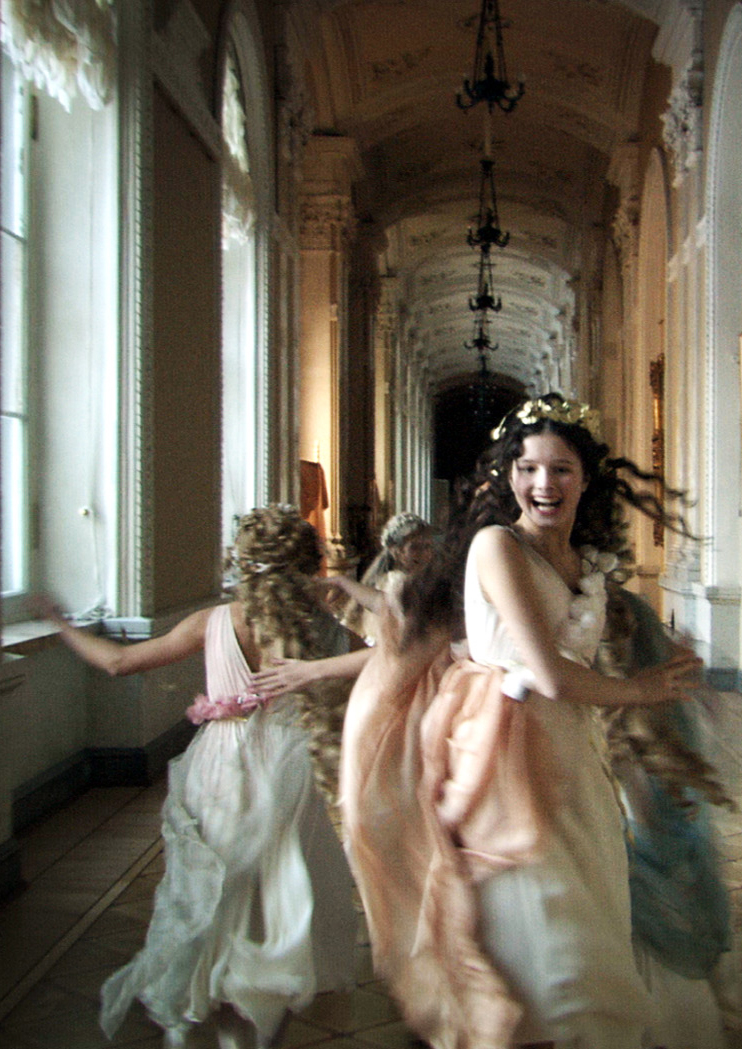
Aleksandr Sokurov
ألكسندر سوكوروف
亚历山大·索科洛夫
Александр Сокуров
Russian Ark
“Alexander Sokurov’s desire to film The Russian Arch in one continuous take required extraordinary technical solutions. Since it is physically impossible to shoot more than twelve minutes of conventional film, we had to shoot on video. However, it was only the relatively recent arrival of 24p high definition compact cameras that offered the visual quality and the ability to make this film for theaters, including transferring the digital image to a 35mm negative.With the help of German specialists a complex portable platform was designed to meet the demands of the scenario which included precise architectural plans, highlighting the distance of 1300 meters covered by the course of the action. It was decided that the only way to move the camera would be to use a steadycam, although we could not be sure until after the final image that such a long steadycam shot would be possible, given the physical performance. extreme demanded from the German cinematographer, Tilman Büttner. After months of rehearsals, the 867 actors and extras, the three “live” orchestras all had to know their position and precise roles “. It’s just amazing.
cinema full

FREDERIK HEYMAN
Formalidade Cerimonial
O trabalho de Frederik Heyman é um ato de equilíbrio que incorpora várias mídias – incluindo vídeo, instalações e fotografia – muitas vezes em um ambiente digitalmente alterado. Em seu trabalho, Heyman explora a memória e a duração, usando fotogrametria e digitalização 3D para retratar e representar a passagem do tempo. As marcas registradas do trabalho de Heyman são mecânicas e tecnológicas: fios, rodas, letreiros LED de rolagem, armações de metal, pinças, lâmpadas industriais, telas e câmeras. Corpos – ao contrário dos humanos – estão sujeitos a uma dinâmica incomum com essas armadilhas tecnológicas. Em Cerimonial Formality (2020), uma contorcionista está presa em uma gaiola de metal enquanto um espectador, preso a fios, observa.
.
Zeremonielle Formalität Frederik Heymans Arbeit ist ein Balanceakt, der mehrere Medien einbezieht – darunter Video, Installationen und Fotografie – oft in einer digital veränderten Umgebung. In seiner Arbeit erforscht Heyman Gedächtnis und Dauer, indem er Photogrammetrie und 3D-Digitalisierung verwendet, um den Lauf der Zeit darzustellen und darzustellen. Die Markenzeichen von Heymans Arbeit sind mechanisch und technologisch: Drähte, Räder, scrollende LED-Schilder, Metallrahmen, Pinzetten, Industrielampen, Bildschirme und Kameras. Körper unterliegen bei diesen technologischen Fallstricken – anders als der Mensch – einer ungewöhnlichen Dynamik. In Ceremonial Formality (2020) ist ein Schlangenmensch in einem Metallkäfig gefangen, während ein kabelgebundener Zuschauer zuschaut.
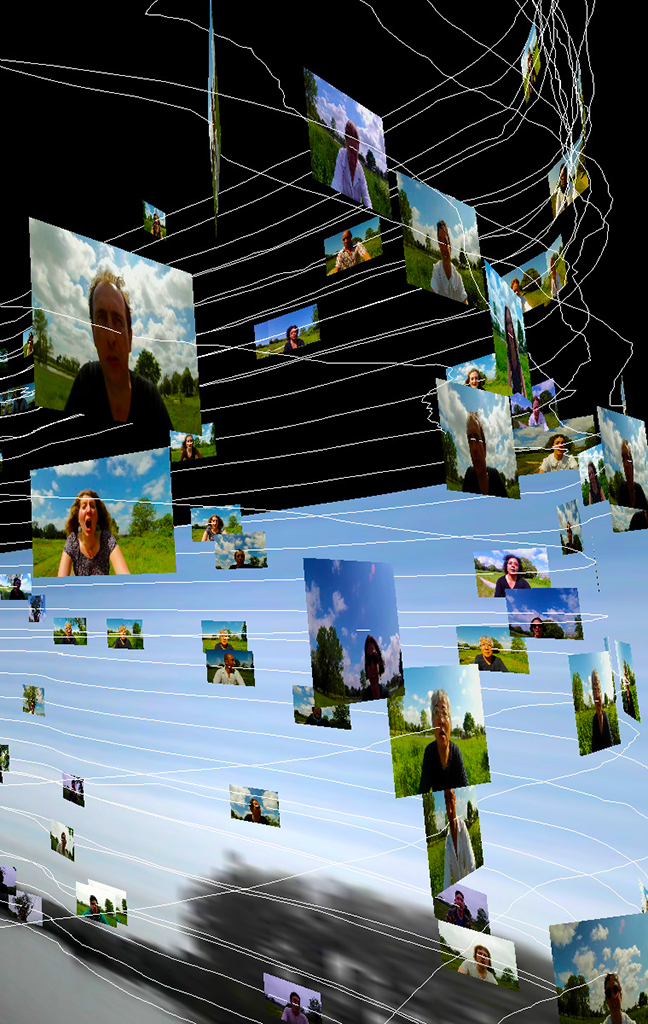
Masaki Fujihata
Voices of Aliveness
This project, upon the initiative of l’Ecole des Beaux-Arts de Nantes, has been conceived as a meta-monument where are gathered video sequences recorded by a camera with GPS. People are screaming while biking in a 500 m circle in the countryside. The traces of this route can be visualized thanks to lines that form a sort of tower in the virtual space, where it can go on indefinitely. On these lines, in an order that looks more like a music score than a succession of shootings, mobile video screens simultaneously display the image of the performances.

Gary Hill
Cutting Corners Creates More Sides
A spoken text …rummages through piles of surplus; boxed accouterments and that unaccounted for miscellanea… and the uneasiness of language itself as it grapples with the whereabouts of the necessary words. The narrative debris morphs through manifolds of optical glass with each utterance marking points along the way. On a long, black tableaux two cameras with little or no depth of field, sentence by sentence cut through a mysterious world of a seemingly inconsequential lineup of objects, tools, parts, bits and the unidentifiable forgotten –whatever might have been close at hand becomes enfolded in a richly colored crystalline doppelgänger image. For each sentence and “drilling” through the objects, the cameras’ parallaxes have been adjusted for a different cross section—the point where momentarily a continuous horizontal view is possible only to then quickly deconstruct as quickly as it formed. The object/installation itself is a self-contained self-reflexive mobile surface complete with positional projectors and screens and a narrow black “runway” of sorts reflecting the initial process of recording.

PATRICK TRESSET
Étude humaine #1
L’installation interactive Human Study #1 de Patrick Tresset se compose de trois robots dessinateurs. Les visiteurs peuvent s’asseoir comme des modèles pour être visuellement enregistrés et représentés par les trois machines. Chacun des trois robots dessine dans son propre style et manie le stylo d’une manière différente. A côté du bras de dessin, chaque robot est équipé d’une caméra mobile. Ils les utilisent pour observer alternativement le modèle et le dessin résultant. Tresset n’est pas intéressé à utiliser les robots pour simuler un style de dessin humain. Il examine plutôt les différences entre l’exécution humaine et robotique. Tresset décrit les capacités de ses machines comme « non intelligentes ». Ils donnent seulement l’impression d’agir de leur propre gré. Ils font preuve d’un comportement humain, mais basé sur un programme ne stipulant qu’un ensemble restreint d’actions.

Aidan Meller
AI-DA
Ai-Da est le premier artiste ultra-réaliste au monde. Elle dessine en utilisant des caméras dans ses yeux, ses algorithmes d’IA et son bras robotique. Créée en février 2019, elle a eu sa première exposition solo à l’Université d’Oxford, « Unsecured Futures », où son art a encouragé les téléspectateurs à réfléchir à notre monde en évolution rapide. Depuis, elle a voyagé et exposé des œuvres à l’échelle internationale, et a eu sa première exposition dans un grand musée, le Design Museum, en 2021. Elle continue de créer de l’art qui remet en question nos notions de créativité dans une ère post-humaniste.

Vitamin Studio
MATT3R
De reis begint in de eerste dimensie, de beelden evolueren en nemen fysieke parameters en constanten op in het gedrag van de verschillende digitale deeltjes. Tijdens de interactieve audiovisuele ervaring reageren de deeltjes op de fundamentele krachten van het universum zoals zwaartekracht, elektromagnetisch, sterk nucleair en zwak nucleair. Omdat licht een fundamenteel element is als het gaat om praten over het universum, de schepping en de materie, bevat Matter een reeks lichtbuizen die reageren op het audiovisuele en deel uitmaken van de interactieve ervaring. Hoe kan het ook anders, Vitamin heeft de hele audiovisuele ervaring ontworpen met interactiviteit. Tijdens de hele ervaring kunnen gebruikers communiceren met de beelden door hun trajecten te wijzigen en parameters toe te voegen, waardoor elke passage uniek en onherhaalbaar wordt. Om de interactie uit te voeren, wordt een reeks dieptecamera’s gebruikt die de beweging vastleggen van mensen rond het afgebakende gebied om te communiceren. De 2D- en 3D-visuals zijn ontworpen met Touchdesigner, een tool waarmee je in realtime audiovisuals kunt ontwerpen, terwijl de audio is ontworpen door Carlos Vera, van Noiz.es, met behulp van Ableton.

ECAL
Automač
Fantastic Smartphones
Built around a simple mechanism, Tinder reduces the act of dating to a single swipe. This slide of the finger to the right or the left is enough to show our interest or disinterest in a profile that comes up. Although high-stakes, even when performed repeatedly, this movement can become purely mechanical and lose its meaning. As its name indicates, Automač is a device that enables us to automatically match with a maximum number of potential partners on Tinder. The automaton consists of a smartphone holder, a camera that observes the screen and a rotating mechanism to swipe on the smartphone screen. Via a screen interface, the user has the possibility to choose selection criteria. By automating this process and delegating it to a machine, Automač positions itself as an optimal machine to have a maximum amount of matches in a minimum amount of time.

Kutin | Kindlinger
ROTOЯ
The Rotor is equipped with a four channel speakersystem and a 360° camera. The artists control the speed of it’s rotation which directly influences the projected video-images as well as the sound-characteristics and the perception of the object itself. Acceleration & deceleration become main parameters, which enables the artists to compose an otherworldly piece that seems to follow it’s own logic. A strange communication between audio, video, object and light establishes itself and seduces the audience. There is the hypnotic movement of the sculpture while inevitable auditory and visual feedback is used as a central aesthetic element: The rotating speakers are amplified by static microphones, provoking complex feedback loops and patterns, that trigger psychoacoustic sensations.

DILLER SCOFIDIO + RENFRO
SLOW HOUSE
To either side of the “picture window” are two antenna-like stacks: the chimney is to the right, the video apparatus to the left. At the summit of the left stack sits a live video camera directed at the water view and feeding the monitor in front of the picture window. The electronic view is operable; the camera can pan or zoom by remote control. When recorded, the view may be deferred— day played back at night, fair weather played back in foul. The composite view formed by the screen in front of the picture window is always out of register, collapsing the opposition between the authentic and mediated.

Liz Deschenes
Galeria 7
Desde o início da década de 1990, Liz Deschenes produziu um corpo singular de trabalho que avançou o potencial material e o escopo crítico da fotografia. Fazendo uso dos aspectos mais elementares do meio, ela recentemente trabalhou sem uma câmera para produzir fotogramas espelhados que refletem nossos movimentos no tempo e no espaço. Sua nova instalação investiga histórias díspares de produção, abstração e exibição de imagens, ao mesmo tempo que responde aos recursos exclusivos do site.

Liam Young
In the robot skies
In the Robot Skies is the world’s first narrative shot entirely through autonomous drones. In collaboration with the Embedded and Artificially intelligent Vision Lab in Belgium the film has evolved in the context of their experiments with specially developed camera drones each programmed with their own cinematic rules and behaviours. The film explores the drone as a cultural object, not just as a new instrument of visual story telling but also as the catalyst for a new collection of urban sub cultures. In the way the New York subway car of the 80’s gave birth to a youth culture of wild style graffiti and hip hop the age of ubiquitous drones as smart city infrastructure will create a new network of surveillance activists and drone hackers. From the eyes of the drones we see two teenagers each held by police order within the digital confines of their own council estate tower block in London. A network of drones survey the council estates, as a roving flock off cctv cameras and our two characters are kept apart by this autonomous aerial infrastructure.

marnix de nijs
PIVOT POINT – ICHIHARA
‘Pivot Point – Ichihara’ is an interactive site-specific installation. Standing on a controller pod you navigate over and through a 3D terrain where gravity seems to have disappeared, you gradually become tele-present in a parallel projected space by exploring a mediated version of the venue, it’s direct surroundings and the Ichihara region. A cinematic journey to a fascinating point cloud realm, precise in details but simultaneously abstract and dreamlike.The kidney shaped interface is covered with capacitive sensors and mounted on a pole, touching this interface right, left, up or down aims the virtual camera accordingly. When you release the navigation pole the virtual camera automatically starts spiralling back to the initial starting point your journey and temporary centre of the universe, the Asohbara Art House.

Noriyuki Suzuki
*(asterisk)
“*(asterisk) is an installation comprised of an armillary sphere apparatus rotating an apple in 360 degrees and four cameras omnidirectionally scanning the surface of the apple in real-time. Computers calculate the similarity between fragmentary images of the present apple and apples I’ve eaten before, as if they were my memory of apples. The computations and compared apple-fragment images are shown on four displays respectively.” Noriyuki Suzuki

RANDOM INTERNATIONAL
随机国际
future self
‘future self’ is a study in human movement. the installation captures movement in light to create a three dimensional ‘living sculpture’ based on the composite gestures surrounding it, mirroring the actions of those who pass around it. entirely hand-made, 30,000 LED lights line the brass rods which are arranged to create a structure reminiscent of a rectangular prism, 3D cameras record people’s motions which are expressed through a ghostly, illuminated image, constantly changing.

HYE YEON NAM
Please Smile
File Festival
“Please smile” is an exhibit involving five robotic skeleton arms that change their gestures depending on a viewer’s facial expressions. It consists of a microcontroller, a camera, a computer, five external power supplies, and five plastic skeleton arms, each of them with four motors. It incorporates elements from mechanical engineering, computer vision perception, to serve artistic expression with a robot.

RALF BAECKER
Memória de acesso aleatório
A Memória de acesso aleatório é uma memória digital totalmente funcional. Em vez de operar em componentes semicondutores para representar os estados binários 0 (zero) ou 1 (um), a memória usa grãos de areia como material de armazenamento. Os grãos de areia podem ser lidos, colocados ou removidos em um disco giratório por um mecanismo de escolha e colocação de três eixos combinado com uma câmera de microscópio para rastrear a posição de um único grão de areia. Esse mecanismo de memória está sujeito a erros por meio de leituras incorretas, grãos saltando e outras imponderabilidades.
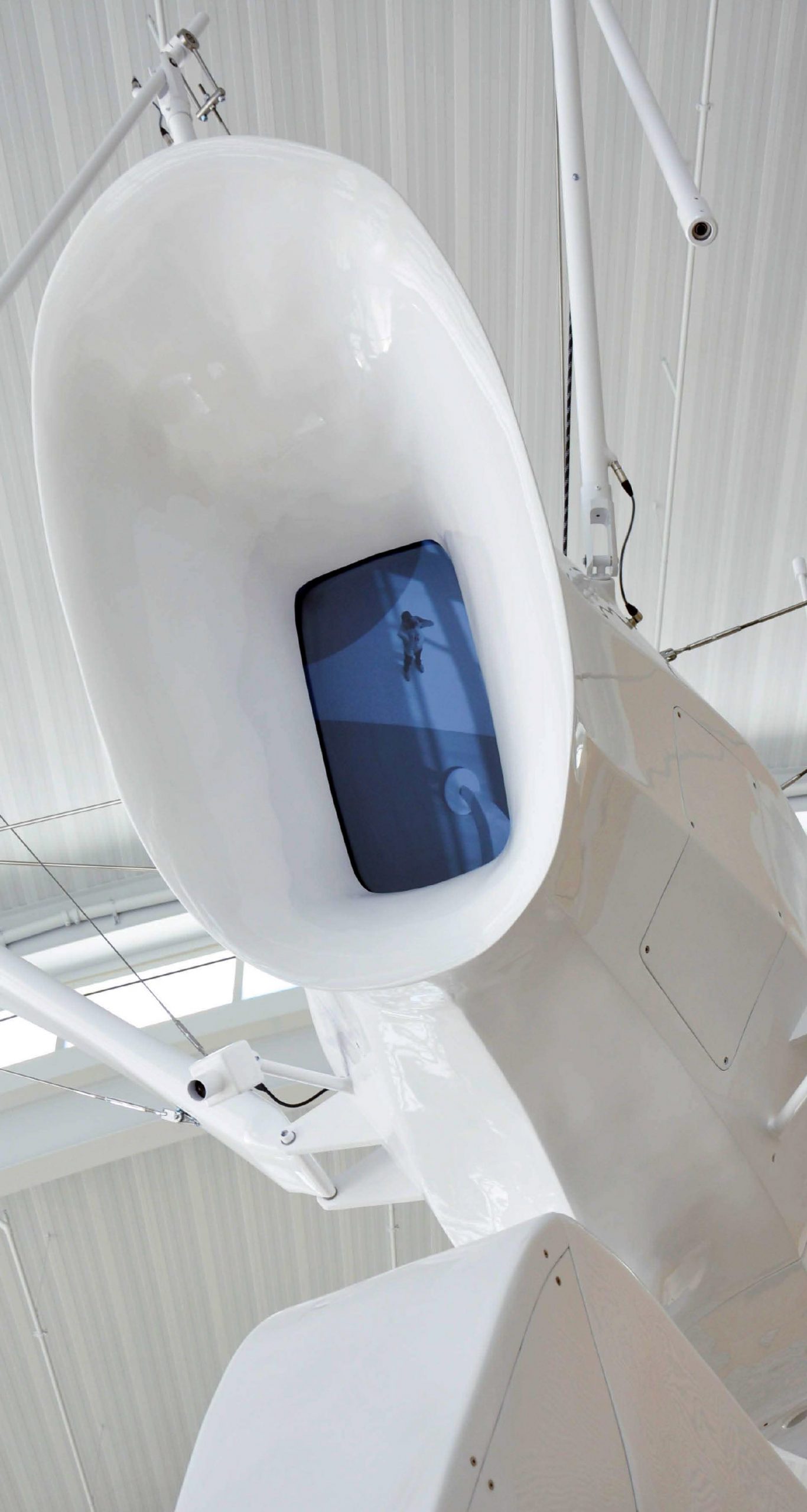
BJOERN SCHUELKE
Observador do espaço
Esta enorme escultura está localizada no aeroporto Mineta San Jose da Califórnia, onde arte de alta tecnologia dá as boas-vindas aos passageiros. No topo da escada rolante do Terminal B, você encontrará a máquina absurda de Schuelke. Esta escultura gigante de três pernas explora a interatividade entre os humanos e a tecnologia moderna. Ele irá girar silenciosamente com a ajuda de dois braços acionados por hélice. E seu ‘olho‘ revela imagens obtidas de câmeras embutidas.

BEHNAZ FARAHI
Caresse du regard
Pour Caresse du regard, Farahi a travaillé avec AutoDesk, PIER9 (où elle est actuellement artiste en résidence) et MADWORKSHOP pour créer une cape couvrant la poitrine recouverte d’une belle couche de plumes en forme de plumes. Bien qu’elles semblent douces au toucher, les piquants peuvent en fait détecter le regard d’un autre (un homme, comme le montre la vidéo ci-dessous) et se dilater et se contracter lorsque ses yeux se déplacent autour du corps. Un microcontrôleur connecté à la caméra de la cape peut également détecter l’âge et le sexe du spectateur, aidant peut-être le porteur à discerner ses motivations.
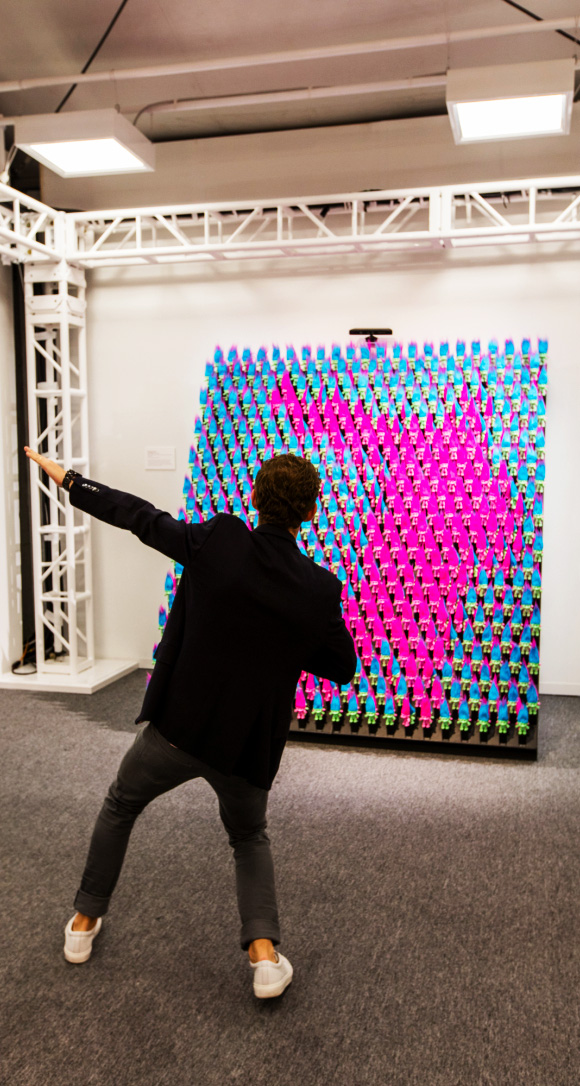
Daniel Rozin
Troll Mirror
The mechanical mirrors are made of various materials but share the same behavior and interaction; any person standing in front of one of these pieces is instantly reflected on its surface. The mechanical mirrors all have video cameras, motors and computers on board and produce a soothing sound as the viewer interacts with them. Troll Mirror was commisioned by Traget and is made of pairs of pink and blue troll dolls. Every troll doll pair can rotate so that the pink or blue troll face the front. The result is a colorfull reflection of the viewer’s outline and playfull colorfull transitions

Abel Gance
Napoleon
Kevin Brownlow’ restoration
Gance embarked on his greatest project, a six-part life of Napoléon. Only the first part was completed, tracing Bonaparte’s early life, through the Revolution, and up to the invasion of Italy, but even this occupied a vast canvas with meticulously recreated historical scenes and scores of characters. The film was full of experimental techniques, combining rapid cutting, hand-held cameras, superimposition of images, and, in wide-screen sequences, shot using a system he called Polyvision needing triple cameras (and projectors), achieved a spectacular panoramic effect, including a finale in which the outer two film panels were tinted blue and red, creating a widescreen image of a French flag. The original version of the film ran for around 6 hours. A shortened version received a triumphant première at the Paris Opéra in April 1927 before a distinguished audience that included the future General de Gaulle. The length was reduced still further for French and European distribution, and it became even shorter when it was shown in America. Napoleon is a silent film directed by Abel Gance, dramatising the youth and early career of Napoleon Bonaparte. Its most complete screening, said to be nine hours long, took place in Paris in 1927 – but this version was subsequently lost. British film-maker Kevin Brownlow saw a version as a schoolboy and subsequently restored the film to close to its original length from various prints. His restoration was first shown in London in 1980 with a score by Carl Davis.
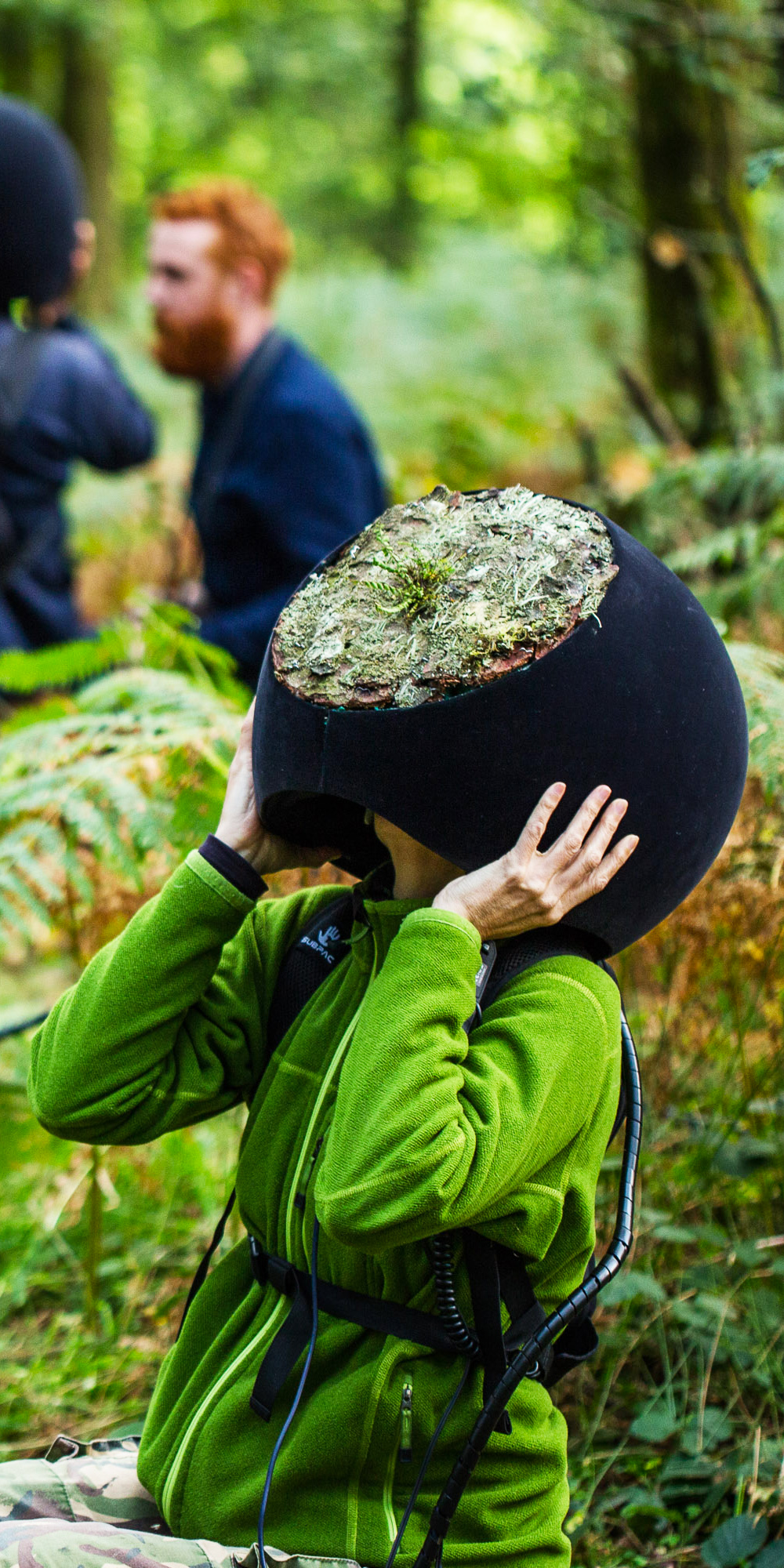
Marshmallow Laser Feast
In the Eyes of the Animal
In the Eyes of the Animal, a journey through the food chain, is an artistic interpretation of the sensory perspectives of three British species. Created using Lidar scans, unmanned aerial vehicles (UAVs) or drones & bespoke 360° cameras, the piece is set to a binaural soundscape using audio recordings sourced from Grizedale Forest in the north of England.

Pablo Valbuena
Kinematope
Kinematope is specific twice over. First, for being formulated as a response to the perceptual qualities and inner structure of the place it activates. Second, its kinematic nature is directly connected to the function of the train station itself: transit, transport, motion. Kinematope uses ephemeral and intangible materials, projected light and sound, to set the space in motion. It makes use of elements from the cinema apparatus to generate a spatial film. It is a direct filmic experience that omits the mediation of the camera, transporting the observer into a virtual space-time and maintaining at the same time the real, physical bonds of the body with its environment.
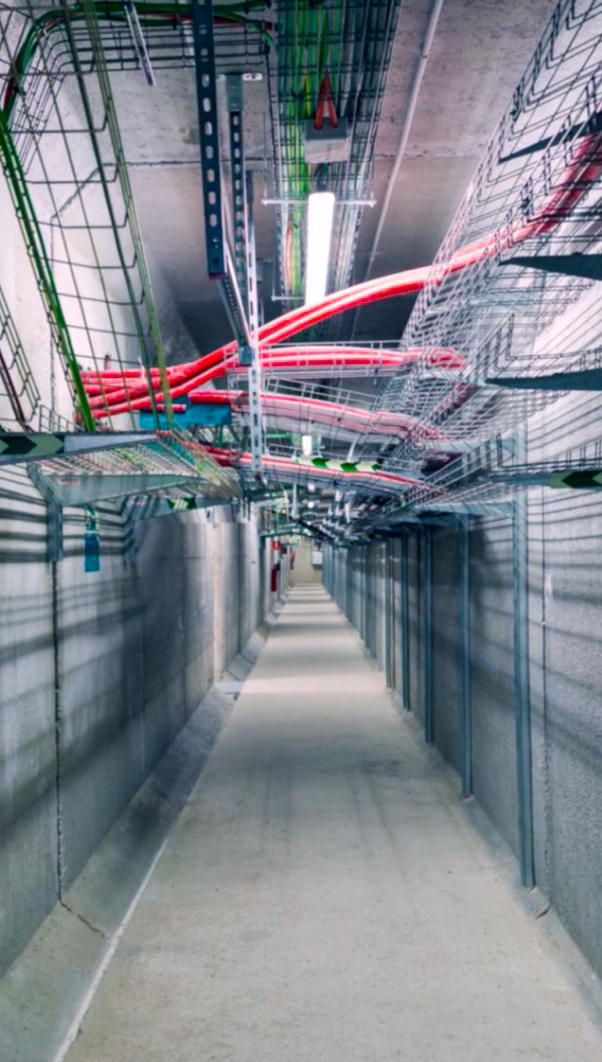
Timo Arnall
Internet Machine
“Internet machine is a multi-screen film about the invisible infrastructures of the internet. The film reveals the hidden materiality of our data by exploring some of the machines through which ‘the cloud’ is transmitted and transformed. The film explores these hidden architectures with a wide, slowly moving camera. The subtle changes in perspective encourage contemplative reflection on the spaces where internet data and connectivity are being managed. In this film I wanted to look beyond the childish myth of ‘the cloud’, to investigate what the infrastructures of the internet actually look like. It felt important to be able to see and hear the energy that goes into powering these machines, and the associated systems for securing, cooling and maintaining them.” Timo Arnall

Jonathan Monaghan
Den of Wolves
Den of Wolves is a video installation drawing on a range of references to weave a new multi-layered mythology. The work follows three bizarre wolves through a series of increasingly surreal retail stores as they search for the regalia of a monarch. Composed of one continuous camera shot, the work is an immersive, dreamlike journey drawing connections between popular culture, institutional authority and technological over-dependence.

Rafael Lozano-Hemmer
Bilateral Time Slicer
A biometric tracking system finds the axis of symmetry of members of the public and splits a live camera image into two slices. With each new participant time slices are recorded and pushed aside. When no one is viewing the work, the slices close and rejoin creating a procession of past recordings.

Rafael Lozano Hemmer
Redundant Assembly
In “Redundant Assembly” an arrangement of several cameras composes a live-portrait of the visitor from six perspectives simultaneously, aligned using face detection. The resulting image is uncanny, detached from the laws of symmetry and the depth perception of binocular vision. If several visitors are standing in front of the work, a composite portrait of their different facial features develops in real time, creating a mongrel “selfie”.

Ief Spincemaille
Reverse Blinking
Imagine that your head is captured inside a photo camera. It is completely dark. Only when the shutter opens en closes, you see the world in a flash. The shutter moves so fast that nothing has time to move. Everything where you point your gaze at, becomes like a photograph. A memory. Something that has been, but isn’t anymore. You see people as frozen figures, whole streets as untouched moments. Life as a sort of dia show. “Reverse Blinking” creates this experience. It is a completely closed helmet with two shutters in front of the eyes. They are controllable by the user. Reverse Blinking works on batteries and can be freely used in or outside the museum. It is best used where there is a lot of movement and people. “Reverse Blinking” is part of a series of art works, through which the artist tries to add video and photographical effects to our natural way of seeing.

Joe Hambleton
Stasis in Flux
“Stasis in Flux is an experimentation of animation’s potential to mimic the real. I began by building a functional zoetrope within 3D space to test if persistence of vision is replicated accurately. From this experiment I realized 3D animations potential to go beyond the physical limits of the real, allowing me to coordinate movements between both the camera and the zoetrope to replicate much more advanced cinematic techniques. The result is a carefully choreographed animation that represents the ebb and flow of the creative process.” Joe Hambleton

Ben Katz & Jared Di Carlo
The Rubik’s Contraption
“That was a Rubik’s cube being solved in 0.38 seconds. The time is from the moment the keypress is registered on the computer, to when the last face is flipped. It includes image capture and computation time, as well as actually moving the cube. The motion time is ~335 ms, and the remaining time image acquisition and computation. For reference, the current world record is/was 0.637 seconds. The machine can definitely go faster, but the tuning process is really time consuming since debugging needs to be done with the high speed camera, and mistakes often break the cube or blow up FETs. Looking at the high-speed video, each 90 degree move takes ~10 ms, but the machine is actually only doing a move every ~15 ms. For the time being, Jared and I have both lost interest in playing the tuning game, but we might come back to it eventually and shave off another 100 ms or so.” Ben Katz

GRINDER-MAN
Mirage
“MIRAGE” is the first performing art ever in the world to experience with immersive. This experience reminds us that we generate ourselves at each moment in our highly subjective ambiguous world. Unlike the general performing arts for the several audiences, “MIRAGE” is generated by the interaction of the two dancers and the one participant. As the participants, you are invited into an 8 minute immersive experience, using a head-mounted display fitted with headphones and a camera to capture live scenes. While unaware of the participant, dancer in front of the eyes is changed over to the dancer that has been recorded in advance. In addition, by overlapping the live scene and recorded ones, participants will experience simultaneous past and present. It is very difficult to tell which dancer is really existing or which is not. Each participant will be required to discover their own “reality”.

Eliška Sky
WOMANEROES
“Eliška Sky’s tribe of ‘womaneroes’ stand bold and bright, their bodies and heads adorned in vibrant shapes, colours, and textures. Beneath the wigs and paint are women of all ages, shapes and ethnicities, photographed with a large-format camera to capture every detail, rough or smooth, with the intention for the images to eventually be printed and exhibited life-size. “It started as visual play, but transformed into a series that challenges depictions of women’s bodies,” explains the London-based Czech photographer. “In light of my own experience of working in the fashion industry, I felt the need to portray the body in new ways and forms, with an element of playfulness and humour in opposition to western media advertising”.” Marigold Warner
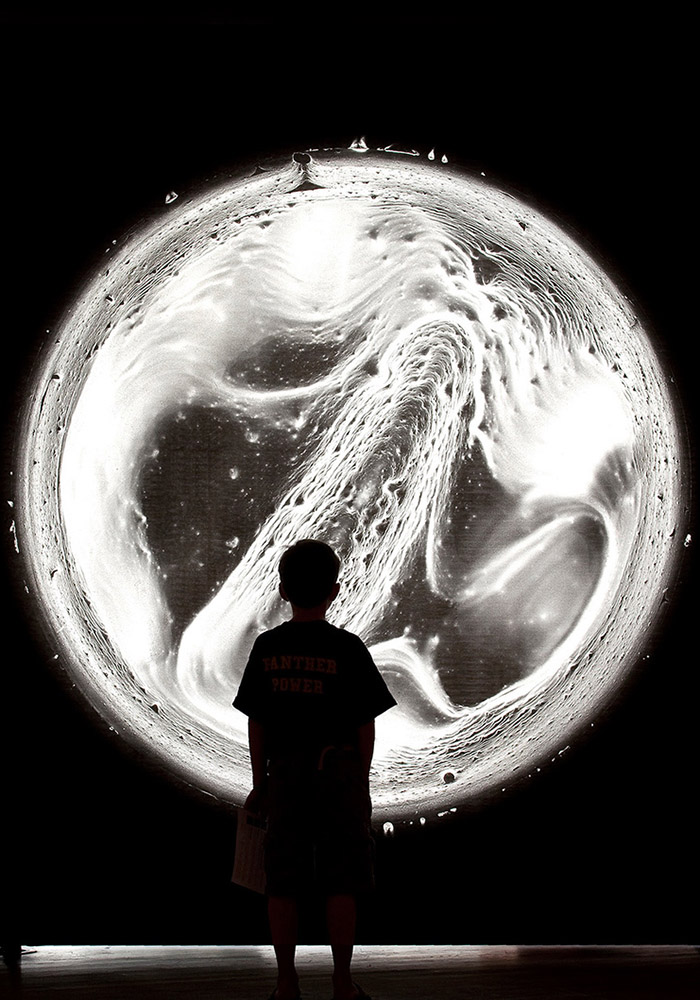
Charles Lindsay
CARBON
CARBON merges the aesthetics of space exploration and scientific imaging with the interpretation of abstract symbols. I’m interested in extremophiles, the origins of life on earth, and what forms sentience might assume elsewhere in the universe. Would we recognize it hovering in front of us? What began with a camera-less method I discovered while experimenting with photograms, and drawing, has grown into immersive environments including large stills, video, multi-point sound and inter-active sculptures.
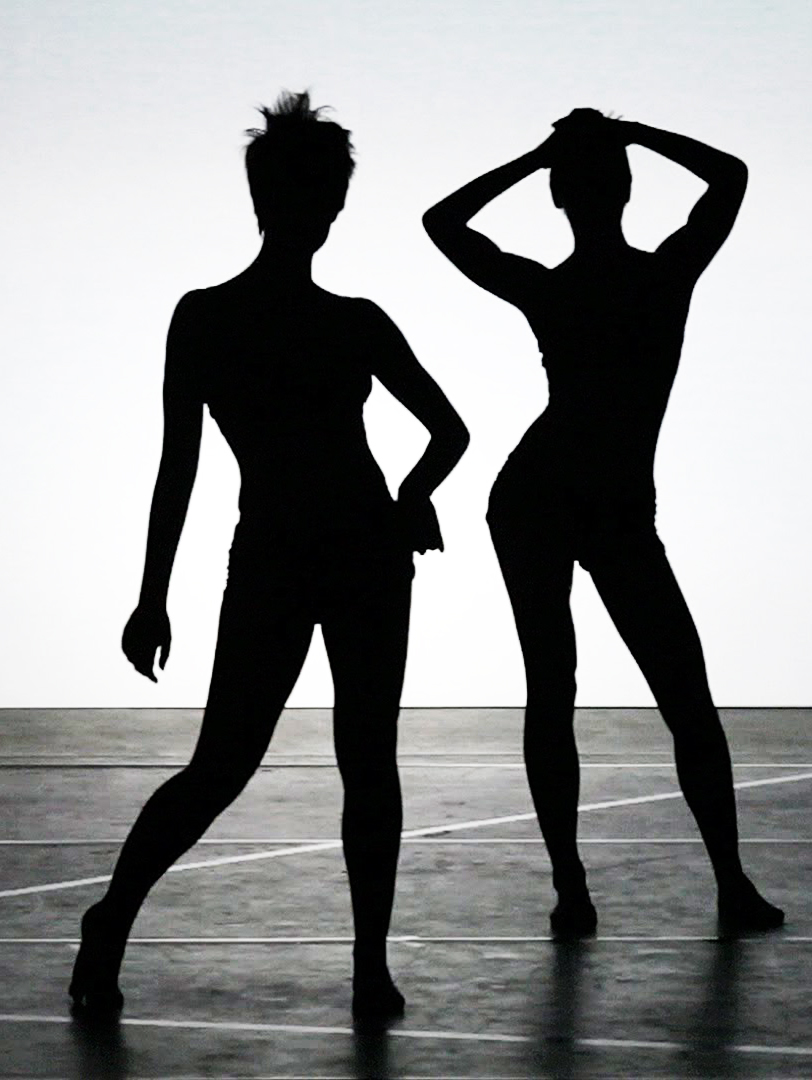
Klaus Obermaier
克劳斯奥伯迈尔
the concept of … (here and now)
In front of a giant screen, two dancers interact with a cohort of cameras… Their movements are captured by infra-red sensors and projected onto the screen, whereby their bodies become the canvas on which new images take shape. The result is a shifting kaleidoscope of strange, living, quasi-mathematical visual worlds which sometimes seem to be emanating or even escaping from the dancers’ bodies. “Who decides which movement to make: the man or the machine?” Blurring the line between the real and the virtual, Klaus Obermaier loves to subsume his performers’ bodies and physicality in a disconcerting digital universe. With his latest creation, the choreographer/artist has taken a bold new step. He has constructed a system of projectors and infra-red sensor-cameras, trained upon the movements of two dancers. The performers thus find themselves thrown headlong into a living, moving graphical universe: their movements are projected onto the screen, but at the same time their bodies are illuminated by more projected images. This is a true artistic performance, pushing well beyond the frontiers of a standard dance recital, or even a contemporary dance show. A corporeal, temporal performance. A choreography which makes subtle use of its raw materials, deftly combining lights, video, perspectives and the real-time power of bodily movement.
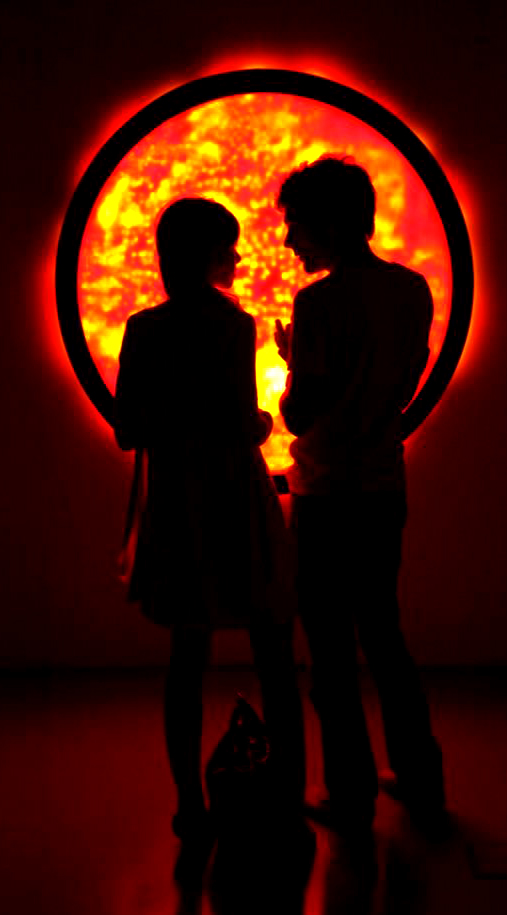
RAFAEL LOZANO HEMMER
Рафаэль Лозано-Хеммер
拉斐尔·洛萨诺 – 亨默
ラファエル·ロサノ=ヘメル
라파엘 로자노
רפאל לוזאנו, המר
Flatsun
A circular display that simulates the turbulence at the surface of the Sun using mathematical equations. The piece reacts to the presence of the public by varying the speed and type of animation displayed. If no one is in front of the piece the turbulence slows down and eventually turns off. As the built-in camera detects people more solar flares are generated and the fake Sun shows more perturbation and activity. At 140 cm diameter, Flatsun is exactly a billion times smaller than the real Sun. The piece consists of custom-made panels with 60,000 red and yellow LED lights, a computer with 8 processing cores, a camera with a pinhole lens and a mechanically engineered aluminium, steel and glass structure that pivots for maintenance. A single knob lets the collector set the brightness of the piece and turn it on and off.

JOSCHI HERCZEG AND DANIELE KAEHR
LAMP
Joschi Herczeg and Daniele Kaehr, originally from Switzerland, surprise the world of photography by capturing movement for the fraction of a second that makes up an explosion.To do this, the two friends used very specific pyrotechnic systems and have even create a custom detonator device, connected and synchronized directly to their camera.

Lauren Lee McCarthy
SOMEONE
SOMEONE imagines a human version of Amazon Alexa, a smart home intelligence for people in their own homes. For a two month period in 2019, four participants’ homes around the United States were installed with custom-designed smart devices, including cameras, microphones, lights, and other appliances. 205 Hudson Gallery in NYC housed a command center where visitors could peek into the four homes via laptops, watch over them, and remotely control their networked devices. Visitors would hear smart home occupants call out for “Someone”—prompting the visitors to step in as their home automation assistant and respond to their needs. This video installation presents documentation from the initial performance on four screens throughout the space.

